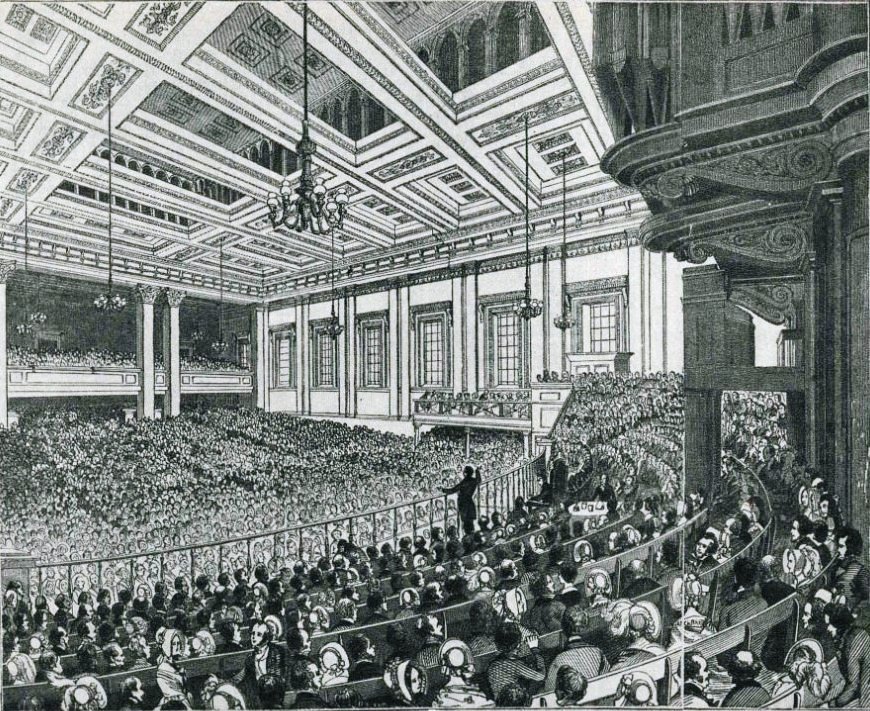Classical liberalism
https://en.wikipedia.org/wiki/Classical_liberalism
Classical liberalism is a political ideology and a branch of liberalism that advocates free market and laissez-faire economics; civil liberties under the rule of law with an emphasis on limited government, economic freedom, and political freedom. It was developed in the early 19th century, building on ideas from the previous century as a response to urbanization and to the Industrial Revolution in Europe and North America.[1][2][3]
Notable liberal individuals whose ideas contributed to classical liberalism include John Locke,[4] Jean-Baptiste Say, Thomas Robert Malthus, and David Ricardo. It drew on classical economics, especially the economic ideas as espoused by Adam Smith in Book One of The Wealth of Nations and on a belief in natural law,[5] progress,[6] and utilitarianism.[7]
Classical liberalism, contrary to liberal branches like social liberalism; looks more negatively on social policies, taxation and the state involvement in the lives of individuals, and it advocates deregulation.[8] Until the Great Depression and the rise of social liberalism, it was used under the name of economic liberalism. As a term, classical liberalism was applied in retronym to distinguish earlier 19th-century liberalism from social liberalism.[9] By modern standards, in United States, simple liberalism often means social liberalism, but in Europe and Australia, simple liberalism often means classical liberalism.[10][11]
In the United States, classical liberalism may be described as "fiscally conservative" and "socially liberal". Despite this context, classical liberalism rejects conservatism's higher tolerance for protectionism and social liberalism's inclination for collective group rights, due to classical liberalism's central principle of individualism.[12] Classical liberalism is also considered closely tied with right-libertarianism in the United States.[13] In Europe, liberalism, whether social (especially radical) or conservative, is classical liberalism in itself, so the term classical liberalism mainly refers to centre-right economic liberalism.[14]
https://en.wikipedia.org/wiki/Classical_liberalism
Classical liberalism is a political ideology and a branch of liberalism that advocates free market and laissez-faire economics; civil liberties under the rule of law with an emphasis on limited government, economic freedom, and political freedom. It was developed in the early 19th century, building on ideas from the previous century as a response to urbanization and to the Industrial Revolution in Europe and North America.[1][2][3]
Notable liberal individuals whose ideas contributed to classical liberalism include John Locke,[4] Jean-Baptiste Say, Thomas Robert Malthus, and David Ricardo. It drew on classical economics, especially the economic ideas as espoused by Adam Smith in Book One of The Wealth of Nations and on a belief in natural law,[5] progress,[6] and utilitarianism.[7]
Classical liberalism, contrary to liberal branches like social liberalism; looks more negatively on social policies, taxation and the state involvement in the lives of individuals, and it advocates deregulation.[8] Until the Great Depression and the rise of social liberalism, it was used under the name of economic liberalism. As a term, classical liberalism was applied in retronym to distinguish earlier 19th-century liberalism from social liberalism.[9] By modern standards, in United States, simple liberalism often means social liberalism, but in Europe and Australia, simple liberalism often means classical liberalism.[10][11]
In the United States, classical liberalism may be described as "fiscally conservative" and "socially liberal". Despite this context, classical liberalism rejects conservatism's higher tolerance for protectionism and social liberalism's inclination for collective group rights, due to classical liberalism's central principle of individualism.[12] Classical liberalism is also considered closely tied with right-libertarianism in the United States.[13] In Europe, liberalism, whether social (especially radical) or conservative, is classical liberalism in itself, so the term classical liberalism mainly refers to centre-right economic liberalism.[14]
Classical liberalism
https://en.wikipedia.org/wiki/Classical_liberalism
Classical liberalism is a political ideology and a branch of liberalism that advocates free market and laissez-faire economics; civil liberties under the rule of law with an emphasis on limited government, economic freedom, and political freedom. It was developed in the early 19th century, building on ideas from the previous century as a response to urbanization and to the Industrial Revolution in Europe and North America.[1][2][3]
Notable liberal individuals whose ideas contributed to classical liberalism include John Locke,[4] Jean-Baptiste Say, Thomas Robert Malthus, and David Ricardo. It drew on classical economics, especially the economic ideas as espoused by Adam Smith in Book One of The Wealth of Nations and on a belief in natural law,[5] progress,[6] and utilitarianism.[7]
Classical liberalism, contrary to liberal branches like social liberalism; looks more negatively on social policies, taxation and the state involvement in the lives of individuals, and it advocates deregulation.[8] Until the Great Depression and the rise of social liberalism, it was used under the name of economic liberalism. As a term, classical liberalism was applied in retronym to distinguish earlier 19th-century liberalism from social liberalism.[9] By modern standards, in United States, simple liberalism often means social liberalism, but in Europe and Australia, simple liberalism often means classical liberalism.[10][11]
In the United States, classical liberalism may be described as "fiscally conservative" and "socially liberal". Despite this context, classical liberalism rejects conservatism's higher tolerance for protectionism and social liberalism's inclination for collective group rights, due to classical liberalism's central principle of individualism.[12] Classical liberalism is also considered closely tied with right-libertarianism in the United States.[13] In Europe, liberalism, whether social (especially radical) or conservative, is classical liberalism in itself, so the term classical liberalism mainly refers to centre-right economic liberalism.[14]
0 Commentarios
0 Acciones
1K Views




